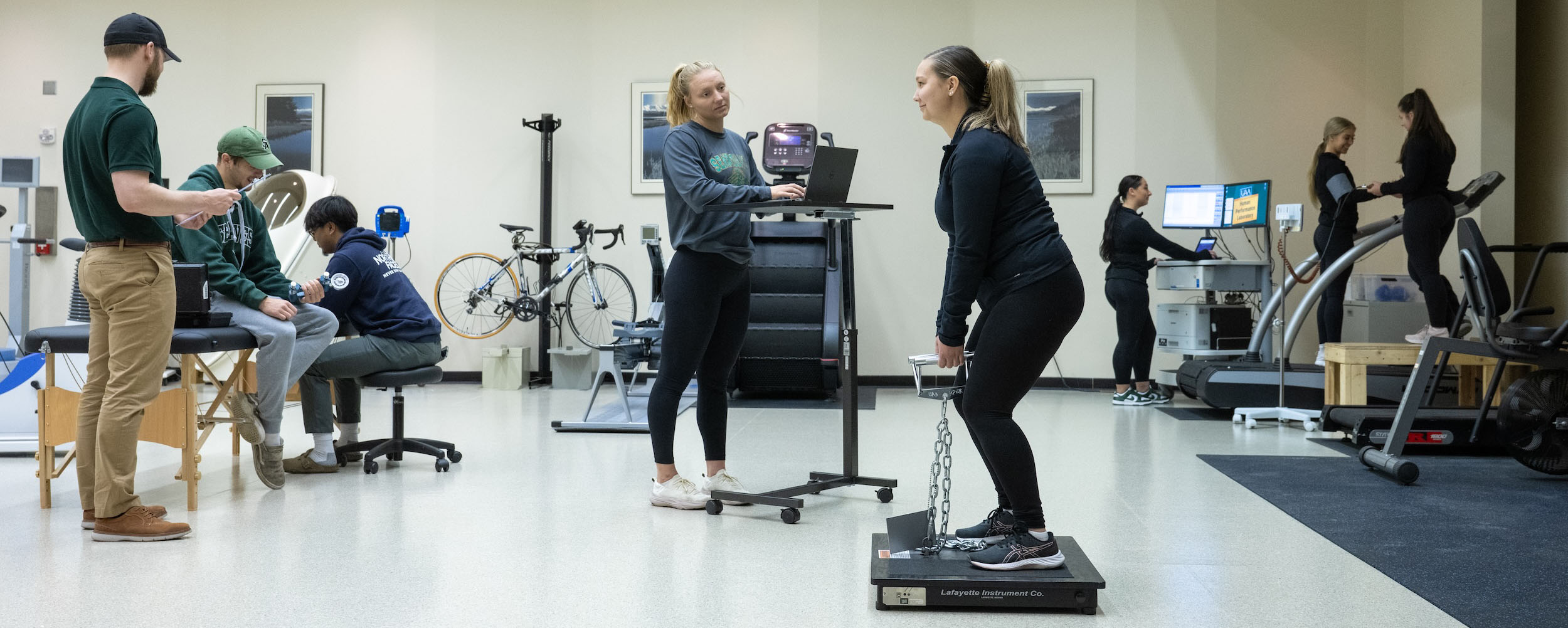Education

The Human Performance Lab's primary function is preparing students for leadership roles in health, physical education, and recreation fields. Working collaboratively with a multi-disciplinary team of health profession educators, students, and staff to promote and incorporate human performance learning experiences. Laboratory courses include kinesiology & biomechanics, exercise physiology, exercise testing, and other special topics.
KIN 382 Kinesiology and Biomechanics
Analyzes the structure, function and mechanics of human movement with an emphasis on exercise, sports and recreational activities. Includes application-based laboratory experiences.
Course Objectives:
- Accurately assess, plan, supervise, and evaluate a person's human performance.
- Critically and ethically evaluate human movement and performance.
- Demonstrate proficiency in evaluating participant performance in sport and recreational activities.
- Apply scientific principles of kinesiology, exercise physiology and motor learning in teaching.
- Describe applied anatomy, anatomical structures, mechanical functions of bones, and
anatomical planes
associated with the human body and movement. - Demonstrate examples of movement terms, muscles involved, and type of muscular including the relationship between the axial and appendicular skeletal system and movement.
- Assess contraindicated movements and describe their effect on the likelihood of becoming
injured or
creating postural malalignments. - Support the use of technology in assisting evaluation and prescription of applied anatomy.
KIN 385 Physiology of Exercise
Analyzes the relationship of physical activity and exercise and the various physiological processes of the human body. Examines the sources and metabolism of energy used to produce movement and other factors that may influence performance.
Course Objectives:
- Discuss the energy continuum from aerobic to anaerobic in relation to exercise prescription
- Discuss special issues related to exercise testing and prescription such as various chronic diseases and special conditions
- Understand the physiology associated with testing and exercise
KIN 454 Exercise Testing and Prescription
Presents techniques necessary for exercise test administration, evaluation and prescription for individuals. Emphasizes clinical physiology, testing protocols, the evaluation of results and the design of individual exercise prescriptions based upon the results.
Course Objectives:
- Critique the risks and benefits associated with physical activity and exercise testing.
- Elaborate on the different types of health screening, risk stratification, and pre-test evaluations and their clinical significance.
- Prepare, conduct, and evaluate physical fitness testing in the areas of cardiovascular, muscular strength, muscular endurance, flexibility, and body composition.
- Integrate the information from physical fitness testing and develop and/or prescribe an appropriate exercise prescription from the date provided.
- Differentiate the needs in developing an exercise prescription for special populations (e.g., elderly, children, pregnant women, cardiac or pulmonary patients, etc.) and those with special conditions (e.g., hypertension, obesity, diabetes mellitus, etc.).
- Identify methods of improving exercise compliance and positively influencing other health behaviors.
- Explain the importance of selected legal issues and guidelines for minimizing risk to human subjects or participants in exercise settings
KIN 455 Clinical Exercise Physiology
Provides an understanding of recent advances in exercise physiology and exercise prescription for clinical populations. Focuses on the study of acute and chronic responses to exercise in patients with cardiovascular, metabolic, pulmonary, orthopedic, immunological, and neurological conditions. Emphasizes the pathophysiology and detection of diseases, medical management, and exercise therapy program design.
Course Objectives:
- Identify elements in heart anatomy and explain the mechanisms of physiological control.
- Evaluate the different types of cardiovascular, metabolic, pulmonary, orthopedic, immunological, and neurological disease and its pathophysiology.
- Differentiate pharmacologic and surgical management methods used in improving a patient’s quality of life.
- Identify basic electrocardiograms (ECGs) and interpret their clinical relevance.
- Prepare and measure a basic electrocardiogram in a normal individual.
- Assess and/or evaluate a cardiac patient’s case history.
- Develop and prescribe appropriate exercise programs for patients with different types cardiovascular, metabolic, pulmonary, orthopedic, immunological, and neurological disease.









